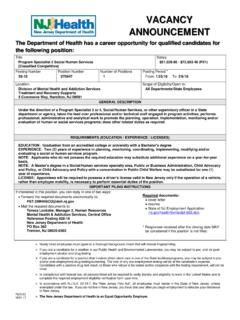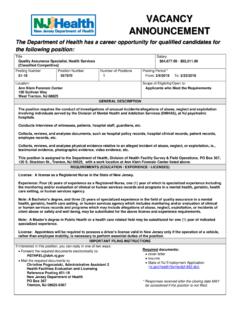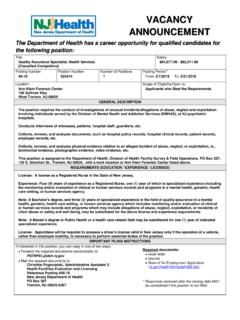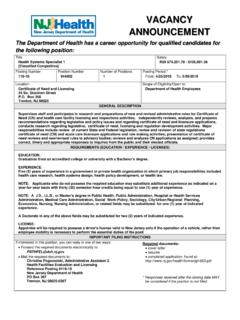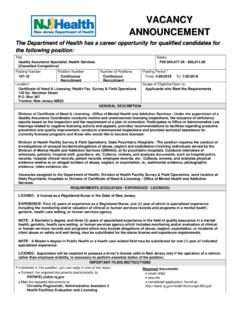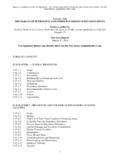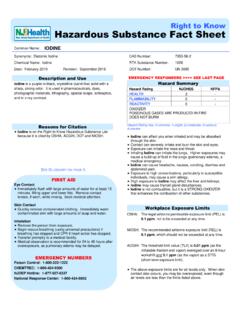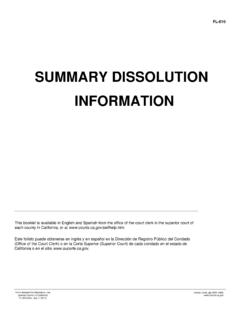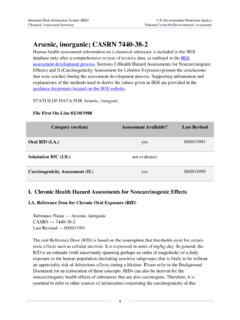Transcription of POTASSIUM PERMANGANATE HAZARD SUMMARY …
1 Common Name: POTASSIUM PERMANGANATE CAS Number: 7722-64-7 DOT Number: UN 1490 ---------------------------------------- --------------------------------- HAZARD SUMMARY * POTASSIUM PERMANGANATE can affect you when breathed in. * Contact can severely irritate and burn the skin and eyes with possible eye damage. * Breathing POTASSIUM PERMANGANATE can irritate the nose and throat. * Breathing POTASSIUM PERMANGANATE can irritate the lungs causing coughing and/or shortness of breath. Higher exposures can cause a build-up of fluid in the lungs (pulmonary edema), a medical emergency, with severe shortness of breath.
2 * POTASSIUM PERMANGANATE may affect the liver and kidneys. IDENTIFICATION POTASSIUM PERMANGANATE is an odorless, dark purple, sand-like solid. It is used in solutions as a disinfectant, deodorizer, bleaching agent, and in air and water purification. REASON FOR CITATION * POTASSIUM PERMANGANATE is on the Hazardous Substance List because it is cited by DOT and EPA. * Definitions are provided on page 5. HOW TO DETERMINE IF YOU ARE BEING EXPOSED The New Jersey Right to Know Act requires most employers to label chemicals in the workplace and requires public employers to provide their employees with information and training concerning chemical hazards and controls.
3 The federal OSHA HAZARD Communication Standard, , requires private employers to provide similar training and information to their employees. * Exposure to hazardous substances should be routinely evaluated. This may include collecting personal and area air samples. You can obtain copies of sampling results from your employer. You have a legal right to this information under OSHA * If you think you are experiencing any work-related health problems, see a doctor trained to recognize occupational diseases.
4 Take this Fact Sheet with you. RTK Substance number: 1578 Date: March 1986 Revision: May 2002 ---------------------------------------- --------------------------------- WORKPLACE EXPOSURE LIMITS The following exposure limits are for Manganese: OSHA: The legal airborne permissible exposure limit (PEL) is 5 mg/m3, not to be exceeded at any time. NIOSH: The recommended airborne exposure limit is 1 mg/m3 averaged over a 10-hour workshift and 3 mg/m3, not to be exceeded during any 15 minute work period.
5 ACGIH: The recommended airborne exposure limit is mg/m3 (as the respirable fraction) averaged over an 8-hour workshift. WAYS OF REDUCING EXPOSURE * Where possible, enclose operations and use local exhaust ventilation at the site of chemical release. If local exhaust ventilation or enclosure is not used, respirators should be worn. * Wear protective work clothing. * Wash thoroughly immediately after exposure to POTASSIUM PERMANGANATE and at the end of the workshift.
6 * Post HAZARD and warning information in the work area. In addition, as part of an ongoing education and training effort, communicate all information on the health and safety hazards of POTASSIUM PERMANGANATE to potentially exposed workers. POTASSIUM PERMANGANATE page 2 of 6 This Fact Sheet is a SUMMARY source of information of all potential and most severe health hazards that may result from exposure. Duration of exposure, concentration of the substance and other factors will affect your susceptibility to any of the potential effects described below.
7 ---------------------------------------- ----------------------------------- HEALTH HAZARD INFORMATION Acute Health Effects The following acute (short-term) health effects may occur immediately or shortly after exposure to POTASSIUM PERMANGANATE : * Contact can severely irritate and burn the skin and eyes with possible eye damage. * Breathing POTASSIUM PERMANGANATE can irritate the nose and throat. * Breathing POTASSIUM PERMANGANATE can irritate the lungs causing coughing and/or shortness of breath.
8 Higher exposures can cause a build-up of fluid in the lungs (pulmonary edema), a medical emergency, with severe shortness of breath. Chronic Health Effects The following chronic (long-term) health effects can occur at some time after exposure to POTASSIUM PERMANGANATE and can last for months or years: Cancer HAZARD * There is limited evidence that POTASSIUM PERMANGANATE may cause mutations (genetic changes). Whether or not it poses a cancer HAZARD needs further study. Reproductive HAZARD * POTASSIUM PERMANGANATE may decrease fertility.
9 Other Long-Term Effects * POTASSIUM PERMANGANATE may affect the liver and kidneys. MEDICAL Medical Testing If symptoms develop or overexposure is suspected, the following are recommended: * Consider chest x-ray after acute overexposure. * Liver and kidney function tests. Any evaluation should include a careful history of past and present symptoms with an exam. Medical tests that look for damage already done are not a substitute for controlling exposure. Request copies of your medical testing.
10 You have a legal right to this information under OSHA Mixed Exposures * Because smoking can cause heart disease, as well as lung cancer, emphysema, and other respiratory problems, it may worsen respiratory conditions caused by chemical exposure. Even if you have smoked for a long time, stopping now will reduce your risk of developing health problems. * Because more than light alcohol consumption can cause liver damage, drinking alcohol may increase the liver damage caused by POTASSIUM PERMANGANATE . WORKPLACE CONTROLS AND PRACTICES Unless a less toxic chemical can be substituted for a hazardous substance, ENGINEERING CONTROLS are the most effective way of reducing exposure.

